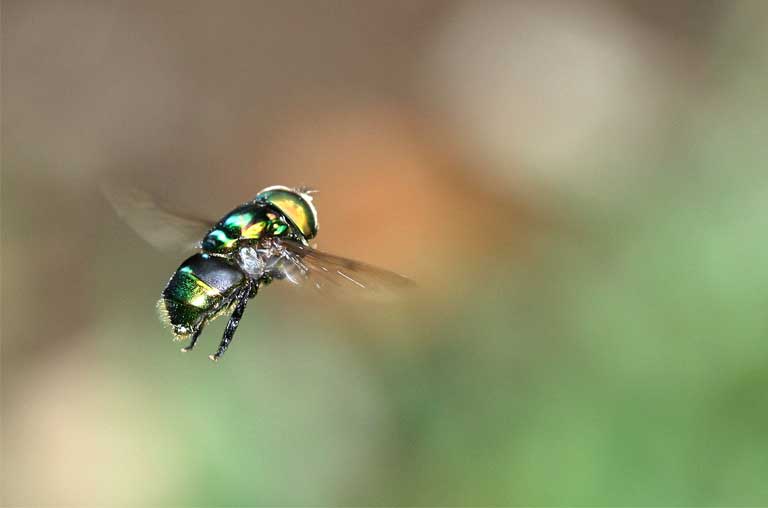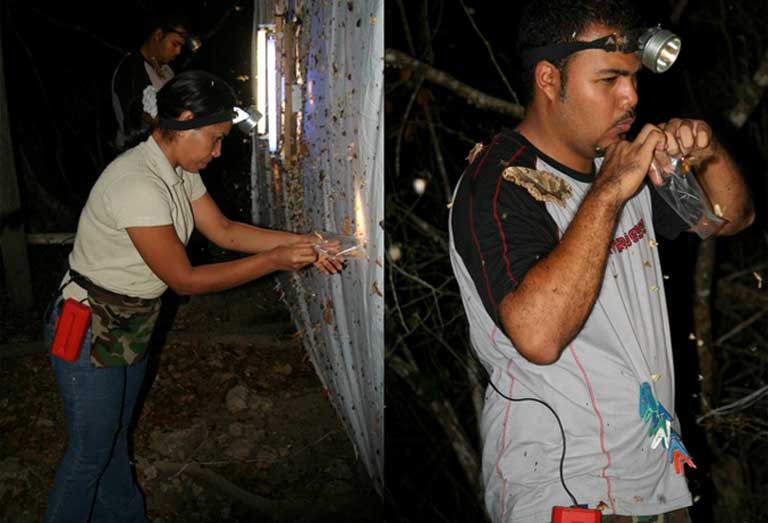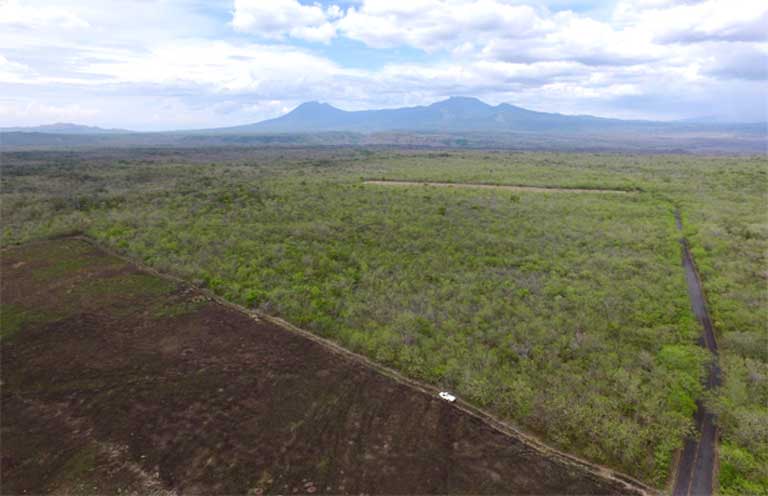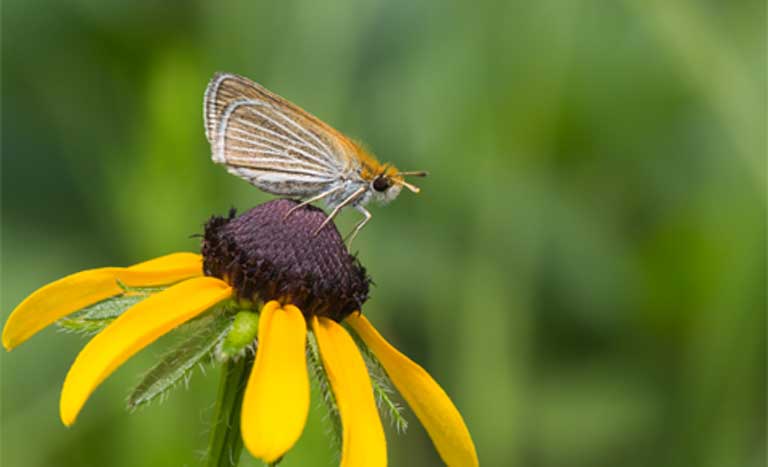- In June 2019, in response to media outcry and alarm over a supposed ongoing global “Insect Apocalypse,” Mongabay published a thorough four-part survey on the state of the world’s insect species and their populations.
- In four, in-depth stories, science writer Jeremy Hance interviewed 24 leading entomologists and other scientists on six continents and working in 12 nations to get their expert views on the rate of insect decline in Europe, the U.S., and especially the tropics, including Latin America, Africa, and Australia.
- Now, 16 months later, Hance reaches out to seven of those scientists to see what’s new. He finds much bad news: butterflies in Ohio declining by 2% per year, 94% of wild bee interactions with native plants lost in New England, and grasshopper abundance falling by 30% in a protected Kansas grassland over 20 years.
- Scientists say such losses aren’t surprising; what’s alarming is our inaction. One researcher concludes: “Real insect conservation would mean conserving large whole ecosystems both from the point source attacks, AND the overall blanket of climate change and six billion more people on the planet than there should be.”

In the middle of the COVID-19 pandemic, in the heart of a what was increasingly a global lockdown, the rains finally came to East Africa. They came after several years of drought and less-than-stellar rainy seasons. And with these rains, came the insects, says Dino Joseph Martins, the executive director of the Mpala Research Center.
“There’s been this beautiful flash of butterflies and everybody’s with their families or at home, or trying to entertain their kids that are not in school, and looking at things in the garden or going on walks,” Martins said in August.
Martins, an entomologist and butterfly aficionado, has become so “inundated” by questions from curious insect onlookers in lockdown that he’s considering “quitting social media” just to have some time to breathe again.
“I think there has been a much broader appreciation of nature [during the pandemic] and it’s because of the loneliness of lockdown, the isolation,” says Martins. “This has been such a blow for so many people.” But, according to the scientist, the pandemic has also unexpectedly awakened many people to the marvels of the natural world and our interconnectedness with it.
It’s a happy anecdote in a year that has seen not only wrenching global change due to the pandemic, but also reams of new research on the potential decline of insects around the world, often dubbed more dramatically as the “insect apocalypse” by the media.

New data fills out increasingly complex global picture
A year after publishing Mongabay’s June 2019 series The Great Insect Dying, I reached out again to some of my scientific sources to see how they viewed new findings across the previous twelve months. None of the seven researchers I spoke with expressed a major shift in their well informed views, which ranged from concern over regional declines, to a wider belief that global insect diversity and abundance may be gravely in trouble.
“My views on the decline haven’t changed drastically but they’ve become more nuanced; I can see that different systems around the world are responding differently,” says Martins, who adds that the last year has shown him that some insect species are remarkably resilient. Still, the entomologist increasingly worries about places like the Amazon which are being devastated—and could be completely transformed — by human-caused fires and climate change.
As for standout studies, a number of the researchers pointed to a meta-study published in Science that looked at insect surveys covering 1,676 sites around the world. It found that land-based insect species, including all pollinators, were dropping by around 9% per decade, an alarming statistic, but one not quite as high as some other research has reported, especially in Europe.
On a more positive note, the study found that water-based insect populations have been rising on average, perhaps due to conservation efforts to clean up waterbodies. However, water loving species represent only around one tenth of the world’s insects — meaning that the majority of insect fauna still appears to be at risk.
Tyson Wepprich, a postdoctoral research associate at Oregon State University, calls this a “benchmark paper.” Still, he adds “there is so much variation between sites and insect groups, [and] there’s no way that a meta-analysis like this could describe what is happening globally.”
Meanwhile, over the past year in Europe — where the alarm over deep insect declines was first sounded — new studies continue shining a light on extensive and startling losses. For example, a study in Germany late last year solidified insect decline there, finding massive declines in both grasslands and forests. Meanwhile, research in Switzerland found that food for insects has plummeted in the country. That hits insect predators too: another Swiss study found that orb-web spiders population density has crashed (140 times lower than Europe’s 1970-80s average). Research in the U.S. shows a more complex picture, with overall abundance potentially more stable, but ongoing declines among pollinators and other species.
One glaring research gap, highlighted in Mongabay’s June, 2019 survey, has yet to be closed by global research conducted since then: almost no new studies cover the tropics. Insect abundance and diversity is highest in the tropics — indeed, insects there help make tropical rainforests the most diverse ecosystems on our planet. But tropical diversity is also at grave risk due to escalating deforestation, and agribusiness, mining and infrastructure expansion.
“I’m still disappointed that the tropics…, and Africa in particular, are very poorly represented,” says Martins.

Numerous sources pointed to one paper out of Costa Rica as one of a few, but one of the best, studies on insect abundance carried out in the tropics recently; it’s findings weren’t heartening. Scientists found that 40% of 64 once-common caterpillar genera had declined over the past 22 years in La Selva, a 1,600-hectare (4,000-acre) forest patch surrounded by agriculture. The study also discovered that the parasitoids that depend on these caterpillars were also in decline.
Another study, this time in the Brazilian Amazon, found that dung beetle populations fell by more than 60% during severe droughts in El Niño years, and by 20% due to forest burning, mostly caused by humans. Dung beetles provide key ecological services, processing waste and dispersing seeds and soil nutrients. Record annual fires are an increasingly common and escalating crisis in the Amazon rainforest, which in the past rarely burned.
Daniel Janzen, a professor with the University of Pennsylvania, who has studied insects in Costa Rica since the 1960s adds to the alarming tropical picture. Janzen has been outspoken as a witness to a long-term insect decline in Costa Rica’s Guanacaste Conservation Area; especially alarming because the losses — as in other parts of the world — are occurring inside a protected area.
“This has not changed,” he says referring to losses over the last year. He notes that taxonomists collecting caterpillars during the last rainy season found that species richness had dropped by 60-80% over what was found just 10-20 year prior.
Insect biomass decline “remains obvious, and levels remain low as they have been for the past 5-10 years,” Janzen says.

Declines driven by deepening systemic problems
In identifying the sources of declines, researchers pointed to the same drivers as last year: climate change, habitat destruction, pesticides and human overpopulation — with habitat loss the most cited in temperate regions, and climate change of highest concern among those working in the tropics.
“Obviously,” says Janzen, “if you nuke a [forest] area for palm oil, beef, soy, peanuts, rice, [or] urban sprawl, the insect diversity and biomass will crash.… A sugar cane field contains not 1% of what was there before. Same for a soccer field.”
But that doesn’t mean pristine or protected habitats are immune, either.
The “overall depressant is obviously the combination of climate change impacts (no research is needed to know that) and millions of tiny small site point source perturbations [occurring] simultaneously,” Janzen wrote via email. “It is shooting someone with a BB gun 1,000 times while they are on a COVID respirator. They will not do well.”
In this analogy, of course, smaller, but innumerable — often intense — human impacts are the BB gun, while all-encompassing global climate change is COVID-19. Bradford Lister, a biologist at Rensselaer Polytechnic Institute, says research demonstrating the impact of a rapidly warming planet on insect abundance has only been “strengthened” in recent years; he pointed to a number of studies showing how heat can harm insect sperm.
Global warming may not only be impacting insects in the tropics, Lister adds, citing a study published this year in Science which found that climate change may be contributing to bee declines in the U.S. and Europe.

Seesawing media coverage, and new U.S. science
While the past year saw increasing coverage of insect decline, including a cover story in National Geographic, it also saw a number of scientists raising concerns about the apocalyptic nature of some of that reporting.
“The issue is not a simple one: generalizations about the state of all insect populations globally are a distraction and can hinder public and political action,” says Manu Saunders, a professor at the University of New England in Australia. Saunders was the lead author on a paper in Bioscience that criticized some of the over-the-top coverage of what has been popularly dubbed the “insect apocalypse,” reportage that she believes promoted “an exaggerated and unlikely narrative.”
Saunders adds: “I am very concerned about the continuing threats insects, and all biodiversity, face. Insects generally are at risk from multiple threats that are directly and indirectly a result of human activities,” but “there is no silver bullet. If we want effective evidence-based action to reduce extinction risk, we need to do a lot more than just quantify species declines or argue about global trends and predictions based on limited data.”
Other coverage, in other media outlets, however, swung the other way: even claiming that declines simply aren’t happening. One such story, published in the libertarian magazine, Reason, declared: The Insect Apocalypse Has Been Cancelled.
The article, which was somewhat more serious than the title, was based on a recent study finding that overall populations of U.S. insects were generally stable across 68 sites, though the research also found some species to be decreasing. The scientists theorized that widespread declines may not be occurring in the U.S. as in Europe, because of lower human population density. They called their study “reassuring,” but others caution as to how such research is perceived.

“I am concerned with how new studies of insect trends are framing their findings as ‘disproving’ the insect apocalypse narrative,” Oregon State University’s Wepprich wrote via email, pointing to how the U.S. study was presented by the University of Georgia in a press release and reported by Reason and other media. “We should probably just agree to stop using apocalyptic terms to describe our findings, whether positive or negative!” he urged.
Recent research published on U.S. insects presents a more nuanced, but still worrying picture. Wepprich himself published a study last year that found butterflies in Ohio to be declining by about 2% per year — a pretty massive decline. Another study, published this year, found that 94% of wild bee interactions with native plants have been lost in New England. Another paper found that grasshopper abundance had fallen by 30% in a protected Kansas grassland over 20 years. While insects in the U.S. might be faring better than in Europe overall, many vital pollinators and other vulnerable species are struggling, or vanishing at alarming rates.
Martins says that the differing media responses and seemingly conflicting scientific findings to the crisis aren’t unexpected, given the massive diversity of insect species, their varying lifestyles, habitats and the complexity of impacts. While some insects being in serious trouble comes as no surprise in our increasingly fragmented, pesticide saturated and warmer world, the scientist suggests that other species may be able to take advantage of local conditions and thrive.
“Insects are very good at adapting and there are definitely a lot of opportunists who are winning in the climate change casino, as I call it, that we’ve built. A good example are the desert locusts who have appeared in East Africa [this year] for the first time in a long time.”
But overall, he said, the trend is one of loss.
“There is no new diversity that we’ve created through our impact on the world that is actually able to replace or even match a fraction of the diversity that we’re losing.”

The future of insects
Clearly, the intensifying focus over the last year on insect loss — all the new research and attempts to measure if, where, or how big the declines may be — is useful to defining a biodiversity crisis that until recently flew largely beneath the radar. But Janzen says we don’t need more research. We know insects are in trouble, he asserts, just as all biodiversity is, and we know what’s causing it (i.e. climate change, habitat destruction, pesticides, etc.). What is needed is action.
“Vastly more important [than more research] is that we put everything into working to ensure that the insatiable human animal does not eat the final dregs of what is left of once massive tropical biodiversity, and more so, is willing to welcome [that diversity] as a productive and useful portion of the human global garden,” says Janzen. “Real insect conservation would mean conserving large whole ecosystems both from the point source attacks, AND the overall blanket of climate change and six billion more people on the planet than there should be.”
There is some political movement, some hope, if largely regional to date. Hans de Kroon, a professor at Radboud University Nijmegen in the Netherlands, attributes the science and reporting on insect decline on the continent for helping to catalyze the European Green New Deal, which was supported by the EU Parliament in January, Poland withstanding.
On the other hand, most sources say they have seen no evidence of growing awareness — or of action — among leaders or the public. Saunders noted that in Australia, the massive, climate-change driven biome-devastating fires last year have led to some discussion over wildlife recovery efforts, but none of those talks are focused on insects.
Since June 2019 the world has changed irrevocably. The COVID-19 pandemic has already led to the deaths of more than a million people, further exposed deep cracks in the global economy, and tested the limits and adaptability of governments everywhere, some proving wiser and more resilient than others. Whether or not the novel coronavirus, likely kickstarted by deforestation and the wildlife trade in China, will ignite a real conversation about our ever-destructive relationship with nature, and lead to a global conservation effort, remains to be seen.
“If you ask me, one of the things that has changed over the past year, is I’m not
as pessimistic… as we’re learning from the greater lessons coming out of the pandemic that nature is incredibly resilient,” concludes Martins. “She a tough old lady she will make it if we just give her a chance.”
Jeremy Hance is a columnist and contributor for Mongabay, and the author of the new book Baggage: Confessions of a Globe-trotting Hypochondriac.

Citations:
Filipe M. França, Joice Ferreira, Fernando Z. Vaz‐de‐Mello, Laís F. Maia, Erika Berenguer, Alessandro Ferraz Palmeira, Rodrigo Fadini, Júlio Louzada, Rodrigo Braga, Victor Hugo Oliveira, Jos Barlow. El Niño impacts on human‐modified tropical forests: Consequences for dung beetle diversity and associated ecological processes. Biotropica, 2020; DOI: 10.1111/btp.12756
Salcido, D. M., Forister, M. L., Garcia Lopez, H., & Dyer, L. A. (2020). Loss of dominant caterpillar genera in a protected tropical forest. Scientific Reports, 10(422). doi:10.1038/s41598-019-57226-9
van Klink, R., Bowler, D. E., Gongalsky, K. B., Swengel, A. B., Gentile, A., & Chase, J. M. (2020). Meta-analysis reveals declines in terrestrial but increases in freshwater insect abundances. Science, 368(6489), 417-420. doi:10.1126/science.aax9931
Ellen A. R. Welti, Karl A. Roeder, Kirsten M. de Beurs, Anthony Joern, Michael Kaspari. Nutrient dilution and climate cycles underlie declines in a dominant insect herbivore.
Proceedings of the National Academy of Sciences Mar 2020, 117 (13) 7271-7275; DOI: 10.1073/pnas.1920012117
Wepprich T, Adrion JR, Ries L, Wiedmann J, Haddad NM (2019) Butterfly abundance declines over 20 years of systematic monitoring in Ohio, USA. PLoS ONE 14(7): e0216270. https://doi.org/10.1371/journal.pone.0216270
Banner image: The larval stage of the Xylophanes anubus moth in Costa Rica. Research into tropical insect loss remains limited, with more studies urgently needed. Image by Daniel H. Hanzen.
FEEDBACK: Use this form to send a message to the author of this post. If you want to post a public comment, you can do that at the bottom of the page.
